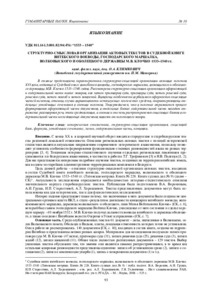Please use this identifier to cite or link to this item:
https://elib.psu.by/handle/123456789/23888| Title: | Структурно-смысловая организация актовых текстов в Судебной книге витебского воеводы, господарского маршалка, волковыского и оболецкого державцы М.В. Клочко 1533–1540 гг. |
| Authors: | Климкович, О. А. |
| Issue Date: | 2019 |
| Publisher: | Полоцкий государственный университет |
| Citation: | Вестник Полоцкого государственного университета. Серия A, Гуманитарные науки. - 2019. - № 10 – C. 93-99. |
| Abstract: | В статье представлена характеристика структурно-смысловой организации актовых текстов XVI века, изданных в Судебной книге витебского воеводы, господарского маршалка, волковыского и оболецкого державцы М.В. Клочко 1533–1540 годов. Рассмотрена структурно-смысловая организация оформляющей и содержательной части таких жанров, как записи приговоров суда, приговоры суда, записи решений суда, решения суда, записи жалоб и записи заявлений. Выявлены особенности вербального оформления смысловых частей текстов, описаны случаи вариативности используемых лексических средств, охарактеризованы отдельные устойчивые сочетания в составе текстов. Утверждается, что в текстах отражается процесс формирования оформляющей части документов, в отдельных блоках содержательной части находит отражение разговорная речь эпохи средневековья, а состав и степень распространения смысловых блоков в содержательной части исследованных документов зависят от текстового жанра.= The article presents characteristics of the structural-semantic organization of the Assembly of the texts of the XVI century, published in the Court book of the Vitebsk Governor, the Lord's Marshal, Volkovysk and Oboletsk sovereign M.V. Klochko in 1533 – 1540. The structural and semantic organization of the formalizing and substantial part of such genres as records of court sentences, court sentences, records of court decisions, court decisions, records of complaints and records of applications is considered. Features of verbal registration of semantic parts of texts are revealed, cases of variability of the used lexical means are described, separate set combinations as a part of texts are characterized. In conclusion, it is stated that the texts reflect the process of forming the formative part of the documents, in separate blocks of the content part the colloquial speech of the Middle Ages is reflected, the composition and the degree of distribution of semantic blocks in the content part of the studied documents depend on the genre of the text. |
| Keywords: | Государственный рубрикатор НТИ - ВИНИТИ::ОБЩЕСТВЕННЫЕ НАУКИ::Языкознание Историческая стилистика Структурно-смысловая организация Смысловой блок Формула Устойчивое сочетание Зачин Содержательная часть Концовка Historical stylistics Structural-semantic organization Semantic unit Formula Set phrase Introduction Substantive part Ending |
| URI: | https://elib.psu.by/handle/123456789/23888 |
| metadata.dc.rights: | open access |
| Appears in Collections: | 2019, № 10 |
Items in DSpace are protected by copyright, with all rights reserved, unless otherwise indicated.
